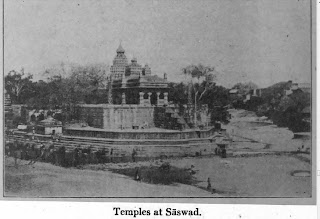Saswad
The name of the village, Saswad came from a tiny settlement near the river Karha, surrounded by seven large Oak Trees. Initially known as Satwad. (Sat means seven and wad means Oak tree), later on its name changed to Saswad.
Saswad gained importance in the Shivaji and Peshwa eras.
After leaving his home at Shrivardhan in Konkan, Balaji Vishwanath Peshwa, came to Saswad.
The Purandare family were the then 'Kulkarni's' and 'Deshmukhs' of Saswad and Balaji was looked after by them.
After receiving the title of Peshwa, Balaji never forgot the Purandare's and gave them important posts in his Administration.
Saswad lies on the banks of the Karha river and is dotted by beautiful temples viz The Viteshwari Temple , The Shiva Temple and the Karha Devi Temple. The Shiva Temple is a masterpiece of architecture.
Shahu Maharaj had given Balaji as "Inam," Pune, Supa, and Saswad. He was the Subhedar of Saswad around 1702. Shahu Maharaj had allowed Balaji to settle down in Supa as the letter states (refer to photograph), and lived in Supa for two years after which he made Saswad his home in 1719. He built a Wada there in Black Stone and it was known as "Kala Wada". Unfortunately there are no remnants of his Wada in Saswad today.
The Purandare Wada stands tall with some of its embattlements still in place. The Purandare family resides there even to this day.
 |
| Purandare Wada (East side) |
 |
| Letter of Shahu Maharaj granting Supa to Balaji Vishwanath |
On the banks of the Karha river and in between the Shiv and Karha devi temple, is the Samadhi and statue of Balaji Vishwanath Peshwa.
The Samadhi is in good condition and is well looked after by the Dev Deveshwar Sansthan of Pune.
Courtesy: 'Peshwe' by Sriram Sathe
Courtesy: Dr Uday Kulkarni, Solstice at Panipat






